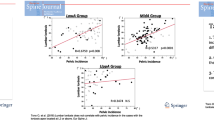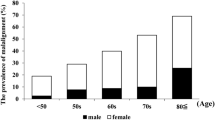Summary
Leg-length inequality and its hypothetical consequences, pelvic tilt and lumbar scoliosis, were measured in 100 young or middle-aged adults suffering from chronic low-back pain. Leg-length inequality had a good correlation with the pelvic tilt assessed from the iliac crests, a moderate correlation with the sacral tilt, but a poor correlation with the lumbar scoliosis. The sacral tilt correlated well with the lumbar scoliosis when the tilt was more than 3° but poorly when it was smaller. Thus, there is a gradually decreasing correlation between the posture parameters when moving from the hips up to the lumbar spine. We conclude that before a radiologically observed leg-length inequality be considered as the cause of low-back pain, an erect-posture radiograph of the whole pelvis and lumbar spine is essential, in order to assess an existing pelvic tilt and scoliosis.
Similar content being viewed by others
References
Amstutz HC, Sakai DN (1978) Equalization of leg length. Editorial comment. Clin Orthop 136:2–6
Cailliet R (1975) Scoliosis. Diagnosis and management. Davis, Philadelphia, p 44
Clarke GR (1972) Unequal leg length: an accurate method of definition and some clinical results. Rheum Phys Med 11:385–390
DeSmet A (1985) Radiology of the spinal curvature. Mosby, St. Louis, pp 40–42
Fisk JW, Baigent ML (1975) Clinical and radiological assessment of leg length. NZ J Med 81:477–480
Friberg O (1983) Clinical symptoms and biomechanics of lumbar spine and hip joint in leg length inequality. Spine 8:643–653
Gibson PH, Papaioannou T, Kenwright J (1983) The influence of leg-length discrepancy after femoral fracture. J Bone Joint Surg [Br] 65:584–587
Giles LGF, Taylor JR (1981) Low-back pain associated with leg length inequality. Spine 6:510–521
Giles LGF, Taylor JR (1984) The effect of postural scoliosis on lumbar apophyseal joints. Scand J Rheumatol 13:209–220
Gofton JP, Trueman GE (1971) Studies in osteoarthritis of the hip. II. Osteoarthritis of the hip and leg-length disparity. Can Med Assoc J 104:791–799
Ingelmark BE, Lindström J (1963) Asymmetries of the lower extremities and pelvis and their relations to lumbar scoliosis. Acta Morphol Neerl Scand 5:221–234
Nichols PJR (1960) Short-leg syndrome. Br Med J 1:1863–1865
Papaioannou T, Stokes I, Kenwright J (1982) Scoliosis associated with limb-length inequality. J Bone Joint Surg [Am] 64:59–62
Rush WA, Steiner HA (1946) A study of lower-extremity length inequality. Am J Roentgenol 56:616–623
Author information
Authors and Affiliations
Rights and permissions
About this article
Cite this article
Hoikka, V., Ylikoski, M. & Tallroth, K. Leg-length inequality has poor correlation with lumbar scoliosis. Arch Orthop Trauma Surg 108, 173–175 (1989). https://doi.org/10.1007/BF00934262
Received:
Issue Date:
DOI: https://doi.org/10.1007/BF00934262




